The Northeastern U.S. is unique when it comes to heating. According to the Department of Energy, 80 percent of the 6.9 million Americans who use oil to heat their homes are clustered in the region. That's because the housing stock there is older and the prohibitive cost of installing new gas lines has prevented a large-scale switch to natural gas. As a result, the region is far more susceptible to price shocks -- a problem that has grown worse in the last few years.
So two years ago, Marian Gogoana, an engineer based in the New Hampshire, started thinking about a solution to the problem.
He designed the HeatMeter, a small wireless device that attaches to an oil furnace or boiler (actually, any type of oil, propane, or natural gas heating system) and monitors the system's activity. He's currently working with his son, MIT grad Radu Gogoana, and a business development manager, Jim Whittaker, to launch Yshape, the company selling the HeatMeter.
"We can see the impact of heating costs in the Northeast first-hand," said Radu Gogoana. "It's a massive expense. And that's why we got into this."
The device is about the size of a pack of cards. It magnetically sticks onto the side of a boiler or furnace and uses a vibration sensor that tells it when the heating system is turned on or off. The user connects the sensor to a wireless router and feeds the information to a computer or a smart phone. After plugging in information about the furnace model, a home's square footage and ZIP code, users can get a daily or weekly picture of their heating system performance while comparing overall energy usage to homes nearby.
Here's what the device looks like when it's attached to the heating system:

We didn't get a direct look at the mobile interface, but you can find a video with a demonstration below. While it doesn't quite have the pop or interactivity that leading mobile home energy management platforms offer, it does what it was designed to do: give a homeowner an easy way to track how their their furnace or boiler is operating.
The HeatMeter has only been installed in a handful of homes. The firm is currently trying to finance the manufacture of the first large batch of meters through a Kickstarter campaign. If the campaign is fully funded, Yshape is offering the device and monitoring service for $150. Without raising the money for the first batch, the device costs $300.
The HeatMeter is in a grey area of invention: it's both a unique technology with little direct competition, and a concept that's already been tackled in other ways by companies.
There's an abundance of home electricity monitors that connect to a meter and feed data to a smart phone. (Some, like those from Google and Microsoft, never took off.) There are also plenty of smart thermostats that allow homeowners to wirelessly monitor and control heating. And when it comes to monitoring fuel use at the furnace or boiler level, there are flow meters available; however, those usually cost a few hundred dollars and require labor to cut the fuel line and install.
"There are a bunch of companies offering different solutions to the problem. We're the only one offering an inexpensive, non-invasive way to monitor heating at the system level," said Gogoana.
The real drawback of the HeatMeter compared to, say, a smart thermostat is that the homeowner doesn't physically control the heating system remotely. It's simply a different way to visualize how the furnace is operating and how that influences energy use. Gogoana said it can be used as a tool to take other action on home efficiency retrofits.
Yshape is targeting individual homeowners first as it launches the product. Eventually, it wants to sell the HeatMeter to fuel dealers, who can market the device to customers.



